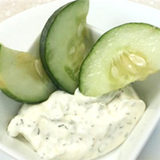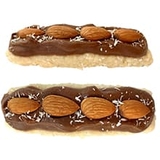Ketogenic diet recipes
Before using, please refer to our Recipe Disclaimer.
The ketogenic diet is a high-fat diet that can be used as part of the treatment plan for children who suffer from seizures. The diet should not be started without supervision and guidance from your child’s medical team.
These recipes are designed to be used by patients who are followed by Children’s Hospital of Philadelphia’s Division of Neurology Dietary Treatment Program. Before using, please refer to our Recipe Disclaimer.
If your child is not already under the care of a CHOP neurologist, and you would like to explore the ketogenic diet, please contact our Pediatric Regional Epilepsy Program for a consultation before trying any of these recipes.
Beginner/starter recipes
Breakfast recipes
- Apple Cinnamon Muffin
- Banana Stuffed French Toast
- Banana Walnut Muffins
- Blueberry Muffin
- Cinnamon Crepes
- Coconut Flakes Cereal
- Frittaffle
- Keto Bread
- KetoCal Blueberry Muffin
- Lemon Raspberry Scones
- Lox Bagel
- “Multigrain” Bagel
- Waffle/Pancake/Muffin (Nut Free!)
- Oatmeal & Berries
- Onion and Cheese Breakfast Muffin
- Pancakes — for helpful cooking tips, watch our video
- Pancakes (almond flour)
- Peanut Butter O's
- Raspberry Fruit Rings
- Turkey Bacon & Swiss Frittata
- Vanilla Blueberry Muffin
- Vanilla Donuts with Chocolate Icing — for helpful cooking tips, watch our video
- Waffle
- Yogurt Parfait
Dips and sauces

- Cheesy Dip
- Honey Mustard
- Marinara Sauce
- Mushroom Dip/Sauce
- Ranch Dip
- Strawberry Jam — for helpful cooking tips, watch our video
Savory recipes
- Almond Crisps
- Ants on a Log
- Apple Pecan Chicken Salad
- Bird’s Nest
- BLT Bowl
- BBQ Pulled Pork — for helpful cooking tips, watch our video
- Broccoli and Cheddar Discs — for helpful cooking tips, watch our video
- Broccoli and Cheddar Soufflé
- Broccoli Cheddar Soup
- Brussels Sprouts, Bacon, and Goat Cheese
- Carrot Stars
- Cauliflower Parmesan Sticks — for helpful cooking tips, watch our video
- Cheddar Crisps
- Cheese Bites
- Cheese Puffs
- Cheesesteaks
- Cheetos and Ranch Dip
- Cheese Biscuit
- Chicken Bites
- Chicken Nuggets — for helpful cooking tips, watch our video
- Chicken and Broccoli Alfredo
- Chicken and Broccoli Stir Fry — for helpful cooking tips, watch our video
- Chicken Veggie Nuggets
- Crab Bisque
- Crab Cakes — for helpful cooking tips, watch our video
- Creamy Chicken Noodle Soup
- Cucumber Dill Bites
- Deviled Eggs
- Egg Foo Young
- Egg Salad
- Goldfish Crackers — for helpful cooking tips, watch our video
- Grilled Cheese
- Ham and Pineapple Rose
- Ham Casserole
- Mac N’ Cheese
- Mac N’ Cheese Bites
- Meatloaf and Mash
- Meatball Cup
- Mozzarella Cheese Stick
- Paneer Korma
- PB & J Sandwich
- Pepper and Onion Empanadas
- Pepperoni Bites — for helpful cooking tips, watch our video
- Pigs in a Blanket — for helpful cooking tips, watch our video
- Pita Chips
- Pizza (almond flour)
- Pizza — for helpful cooking tips, watch our video
- Pizza - Eggless
- Pizza Mash
- Pizza (Nut Free!)
- Potato Chip Fish Sticks
- Saag Paneer
- Salmon Avocado Sushi
- Salmon Burger with Avocado
- Sausage and Beet Stew
- Sausage and Quinoa
- Savory Holiday Muffin
- Shrimp and Bok Choy Lo Mein
- Shrimp & Feta Salad

- Soft Pretzel
- Spaghetti and Meatballs
- Stuffed Cheesy Mushrooms
- Stuffing and Turkey
- Tacos
- Thai Harvest
- Tomato and Beef Lasagna
- Tomato Basil Soup
- Tuna Salad
- Veggie Fries — for helpful cooking tips, watch our video
- Zucchini Pancakes
- Zucchini Pasta with Pesto
- Zucchini Ravioli
Sweet recipes
- Almond Coconut Candy Bar
- Apple Caramel Cake

- Avocado Brownies
- Birthday Cupcake
- Blueberry Yogurt Bunnies
- Caramel Pecan Tarts
- Carrot Cake Cookies
- Cheesecake
- Chocolate Brownie
- Chocolate Chip Cookies — for helpful cooking tips, watch our video
- Chocolate Chunk Cookies
- Chocolate Nut Fudge
- Chocolate Peanut Butter Cups
- Chocolate Pudding
- Churros
- Cinnamon Graham KetoBar — for helpful cooking tips, watch our video
- Cinnamon Pecan Cookies
- Cinnamon Rolls
- Coconut and Peanut Butter Candies
- Creamy Jell-O®
- Creme Brulee
- Cupcakes with Chocolate Buttercream Frosting
- Festive Jell-O Cup
- Gummy Bears
- Iced Pumpkin Cake
- Ice Cream Cone
- Frozen Fruity Cream Cheese Treats — for helpful cooking tips, watch our video
- Fudge Brownie — for helpful cooking tips, watch our video
- Jell-O Parfait®
- Key Lime Pie
- Lemon Almond Cake — for helpful cooking tips, watch our video
- Marshmallows
- Marshmallow Cereal Treat
- Nut Bars
- Orange Creamsicle Ice Cream
- Peanut Butter Cookies
- Pumpkin Fudge Pops
- Pumpkin Pecan Cheesecake
- Raspberry Meringue — for helpful cooking tips, watch our video
- Snickerdoodle Cookie
- Strawberry Chocolate Ice Cream
- Strawberry Coconut Ice Cream
- Strawberry Shortcake
- Strawberry Sunflower Bar — for helpful cooking tips, watch our video
- Strawberry Valentines
- Sugar Cookies
- Vanilla Cream Cakes
- Vanilla Ice Cream
- Watermelon Sorbet
- Whoopie Pie
Modified diet recipes
The modified ketogenic diet (MKD) recipes should only be followed if specifically prescribed the MKD by your medical team.
- Birthday Cupcake
- Broccoli Cheddar Discs
- Cauliflower Parmesan Sticks
- Cheese Pizza
- Chicken Bites
- Chocolate Glazed Donuts
- Oatmeal & Raspberries — for helpful cooking tips, watch our video
- Waffles
Helpful Tips & Tricks
The Ketogenic Diet
Fat Hiding Tricks
- Combine weighed heavy cream and mayonnaise with weighed raw eggs, cook the mixture in a pan to form fluffy scrambled eggs.
- Add weighed canola oil to weighed yogurt; the oil will completely absorb and blend into the yogurt.
- Mix weighed room temperature butter into weighed creamy peanut butter. This not only helps hide fat, but also increases the volume of the spread.
- Add weighed canola oil into weighed liquid heavy cream. Use a milk frother (used to make cappuccinos) to emulsify the two together perfectly. Can be served as a drink!
Cooking Tips
- When weighing your ketogenic ingredients in one bowl, always start with the dry ingredients. Try to form small mounds of the dry ingredients while weighing to allow for easy removal if the weight goes over. The liquid ingredients (heavy cream, oil, etc.) should be weighed in a separate bowl individually. The reason for this is because if you weigh two liquids together and go over on the weight, you will not be able to safely remove the one liquid due to them mixing together.
- Always be sure to use nonstick cooking spray (any brand). Ketogenic foods tend to stick more than regular foods due to their high fat content. It’s important that no food residue is left behind on any cookware to avoid losing nutritional value.
- Dry seasonings can be used on the ketogenic diet as a “free” ingredient (single dry seasonings only, not pre-packaged mixes). In large quantities, fat tends to mask the natural flavors of foods that we know and love, therefore we encourage you to season the foods with dry seasonings to make them tasty and enjoyable. Especially salt!
- Ketogenic foods generally freeze very well, however the reheating process can be tricky. When reheating foods, the fats always tend to melt first, which is the main component for ketogenic foods. The best way to reheat keto foods is in the oven or on the stove top.
- When baking ketogenic foods, never fill molds all the way to the top (¾ full is ideal). During the baking process, the heat may make the fat separate from the recipe, creating a pool of fat on the top. If the recipe is filled all the way to the top, the melted fat will go over the edge and result in loss of nutritional value. To avoid this from happening, fill only ¾ of the way full, then allow the recipe to fully cool and reabsorb the fat before removing from the mold.
- How to Calculate
- Batch Cooking 101